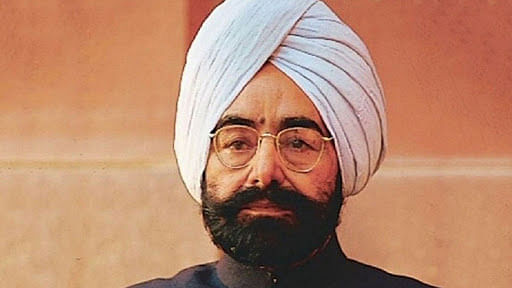On his 24th death anniversary, ThePrint looks back on the life of Giani Zail Singh, from freedom fighter to President of India.
In 1994, when the other parts of the world were celebrating Christmas, India was mourning the death of former president Giani Zail Singh.
In his long career, the former president held a number of portfolios. His presidency saw him brave some of the darkest moments in the history of independent India — Operation Blue Star, former prime minister Indira Gandhi’s assassination and the anti-Sikh riots that followed.
But Singh is most well-known for his unwavering loyalty to Gandhi. On his appointment as president, Singh reportedly said he would sweep Gandhi’s courtyard if she asked him to.
Singh remains the only Sikh president India has had.
On his 24th death anniversary, ThePrint takes a look at his journey from a freedom fighter to the country’s highest chair.
Also read: Once a soldier, always a soldier: The Sikh general who didn’t give Blue Star a second thought
Early life
Born Jarnail Singh on 5 May 1916, to a peasant family in Sandhwan, in the princely state of Faridkot, he involved himself early on in religious scholarship by gaining a mastery of Sikh holy scriptures and doctrine, including the Guru Granth Sahib.
He inherited religious leanings and spirituality from his father. He also was well-versed in Urdu and knowledgeable about Hindu scriptures and mythology.
It was after completing a course at the Shahid Sikh Missionary College in Amritsar that he earned the title ‘Giani’, which is conferred upon an individual proficient in religious studies.
Also read: Indira Gandhi’s damage to democracy has resulted in mis-governance to this day
Political career
Affected by the execution of Bhagat Singh, he got involved in politics at a young age and participated in the Indian freedom movement. He established a unit of the Indian National Congress in Faridkot in 1938, an act that landed him in jail for five years.
During his time at Tihar jail as a prisoner, he changed his name from Jarnail to ‘Zail’.
He formed Praja Mandal (1946-1948) in Faridkot, an ally of Congress, and remained a vocal critic of Raja Harinder Singh, the ruler of the erstwhile Faridkot state.
After the first general election in 1951-1952, Singh rose to become the agriculture minister of Patiala and East Punjab States Union (PEPSU). He also served as the president of PEPSU Pradesh Congress Committee from 1955 to 1956 when it was consolidated with Punjab.
His political pursuits and undeterred determination to fight for democratic rights led to then prime minister Jawaharlal Nehru take notice of him and his work. Singh was elected a Rajya Sabha member from 1956 to 1962.
After having served several offices in the Punjab government, he was elected the Chief Minister of the state in 1972.
Reports suggest that under his tenure, Punjab came to be called the “wheat bowl” of the country.
When Indira Gandhi was out of power in 1977-1979, the situation was tough not just for her but for other Congress leaders too, including Singh.
He remained loyal to Gandhi even when anger had built up against her during the Emergency. When the Congress government came back to power in 1980, Gandhi rewarded him with home affairs ministry, which he retained till he was named the president in 1982.
As president
His presidency’s darkest moment came during Operation Blue Star. As Singh himself said, Gandhi didn’t take him into confidence before ordering troops to storm the Golden Temple in 1984.
Singh faced backlash from his community and was accused of complicity in staging the operation. He was labelled a “mute spectator”.
In Memoirs of Giani Zail Singh, the former president wrote, “I told Mrs Gandhi it would have been more appropriate if I had been given prior information about such a significant and far-reaching decision to storm the golden temple. She parried this observation.”
Singh was excommunicated by his community. But his troubles didn’t end there. Gandhi was assassinated on 31 October the same year and in the riots that broke out soon after Sikhs were killed in large numbers.
After her assassination, in his national address, Singh said, “Our beloved Mrs. Indira Gandhi is no longer with us. I have lost my dearest friend; we have all lost one of the greatest leaders our country has ever produced; and the world has lost a harbinger of peace who was undoubtedly the greatest woman leader mankind has ever produced.”
Last days
Regardless of challenges and backlash from political leaders, Singh continued to carry out his duties as president and completed his term.
In November 1994, he met with a car accident and died a month later in Chandigarh. A year later, the Department of Post issued stamps to commemorate Singh.







I understand that when one is a President, he or she does not represent a certain segment or section such as women, Sikh, Muslim, Hindu etc. and their causes but the entire nation. Still, I think, Giani Ji could have done more for the Sikhs and India. Some Indians question Sikh loyalty, even though most sacrifices in all wars and Independence were done by Sikhs. One should not have to choose between his or her faith and the Country! Faith and its values are what guides one to rule and run a country after all and not the other way around. Some people in India think, secular means giving up one must not profess faith and showing it means less loyalty to the Country, which is not true. One that shows faith in the Guru, probably has credibility to show that he or she can be trusted. How can one that can’t be loyal to his or her faith be trusted to show loyalty to his fellow citizens! India would be better to have a spiritual-warrior run a country than a non-spiritual or just spiritual who has never seen a fight or promotes complete non-violence!